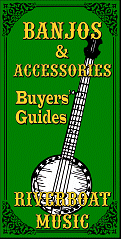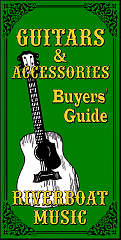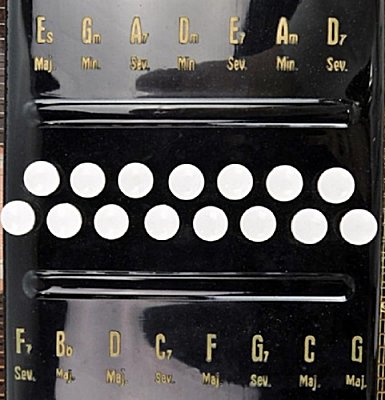


|


Musima Autoharps
When Westerners think of East Germany, there are a lot of negatives. But few folks know that the "German Democratic Republic" had a thriving musical instrument manufacturing business. Much of it centered in towns like Markneukirchen and Klingenthal, Germany, both towns in the region called Saxony, on the border of the Czech Republic. This region had been known for quality instrument manufacturing since at least the 17th century.Markneukirchen come into our narrative for two reasons:
- Markneukirchen was also the birthplace of Karl G?tter (1823-1900), the man who invented the instrument we call the autoharp. (Zimmeran patented a different instrument, but used G?tter's design when he actually started manufacturing autoharps.)
- During the years of the GDR, it was the headquarters of an instrument manufacturing "collective" called Musima, the brand we're looking at in this article.
We'll also be looking briefly at the history of German autoharp manufacturing and the involvement of one family whose designs and experience made the Musima autoharps (and chorded zithers) desirable throughout Europe during the GDR era.
Early German Autoharp Manufacturing In 1883, G?tter sold the patent rights to musical instrument purveyor Herman Lindemann from the nearby town of Klingenthal. But other folks besides Zimmerman found it easy to copy G?tter's design.
By 1890, Lindemann was suing other companies for making copycat instruments, in violation of the patent he had paid for. By that time, at least three names were being applied to Lindemann's instrument and its copycats: Volkszither, Chordzither, and Autoharp. (For details about this history, please check out Ivan Stiles' article "The True History of the Autoharp."
The Hopf Family Gets Involved - At some point (probably after 1901) members of a Klingenthal family with a three-century tradition of violin-making began making autoharps. Initially, like Zimmerman's autoharps, these were influenced by G?tter's design. But unlike most of the other manufacturers, the Hopfs also made "chorded zithers," an instrument without chord bars whose body shared the same physical construction. Based on that experience, even their earliest models diverged in some ways from Zimmerman's.
And as the autoharp market and design developed, they "went their own way" regarding the tunings and chord combinations they used. (For details, please visit our article "Hopf Autoharps.")
The Hopf family was making autoharps and zithers right up through World War II - an unusual experience when nearly every other German factory had been repurposed for the wartime effort. For most of those decades, their "brand" was indicated, not by the family name nor by false claims of patents, but by an elaborate rose decal that went on the front of nearly every instrument. For that reason, early- to mid-century Hopf-manufactured instruments are often called "Rosen," as though that were the brand name.
Note: It is possible that some of the German-manufactured autoharps and zithers with elaborate rose decals were not actually built by the Hopfs. But I have yet to come across one that I was certain was not of Hopf origin. If you find one, please get in touch, and we'll revisit this section.
Sadly, the Hopf family's fortunes, as well as their instruments, changed when East Germany's communist leaders decided to capitalize on the historical success of Saxony's music instrument manufacturers. They determined to reorganize and re-lable companies like the Hopfs' to make it look as though communist principles were responsible for that success.
As an interesting aside, in 1948, another branch of the Hopf family - probably seeing the writing on the wall - hived off to a town in "West Germany," bringing some of their tradespersons with them. There in Taunusstein-Wehen, their descendants are currently making high-end guitars under the name Dieter J. Hopf.
The Hopfs who remained in Klingenthal suffered personal hardship, but their instrument designs and workers definitely helped keep the supposed "collective" afloat.
For more about the Hopf family's involvement with autoharp development, please visit our article "Hopf Autoharps."
The "Musima" Umbrella - As hinted above, a few years after the GDR was formed, the government brought many of the luthiers, tradesmen and other workers in Markneukirchen and surrounding towns under the "Musima" branding umbrella. In the Hopfs' case, they accomplished that by declaring that the company's leader was an enemy of the state and imprisoning him while they impounded his shares in the company.
In spite of gradual nationalization that was completed by 1972, it's probable that the Hopf factory continued to operate in nearby Klingenthal. The current iteration of the company does operate there, if that's any indication.
But "Musima's" captive manufacturing base didn't just make zithers and autoharps. They also built violins, mandolins, banjos, and guitars. Those probably came from other formerly independent businesses that the GDR nationalized.
Ironically, the guitars included solid-body electrics based on the "decadent" musical instruments of the West. But since the Musima luthiers were generally working from photographs, the instruments' necks weren't always the best design. Today, they're considered collectors' items or curiosities more than desirable performance instruments. For more information about Musima guitars, click here.
I would not be surprised if factories under the Musima umbrella built brass and woodwind instruments as well, since Saxony was a traditional source of those as well. But I haven't seen any direct evidence.
Apparently many of the craftspeople who had worked for the factories that Musima absorbed kept their jobs and kept doing the best they could under increasingly difficult circumstances. My heart goes out to them. There is great value in doing what you love and making things that bring joy to other people, no matter whose flag is flying over your factory.
Musima Zithers - It's not surprising that Musima offered zithers, since those were popular all over Germany in the early 1900s, and they were the Hopfs' most popular product line. I include these in the discussion because zithers like the ones shown below require much of the same manufacturing materials and techniques as autoharps.
The Musima zither examples I've come across are in the category of "chorded zithers." They have pre-formed chords on the strings closest to the player, and individual strings further out for picking the melody. This was a popular configuration by, say, 1900, and obviously still popular decades later.
To the left below is a 27-string, 3-chord zither that was obviously built as a student instrument. It has three preformed chords, F, C, and G, and two octaves of a diatonic C scale (like a piano with no black keys). Many instruments of this class are labeled "Jubeltone," though I have seen one upgrade 3-chord Jubeltone with chromatic scales and the wildflower pattern. As far as I know, it is still from the GDR era.
 |
 |
To the right above is a 72-string, 6-chord zither that is obviously built for serious use. It has C, G, F, D, and A chords, as well as two chromatic octaves in string pairs, like a mandolin. Considering that most autoharps have about 36 strings, it's not hard to imagine that a company that could build this monster would be able to build high-quality autoharps as well.
Before the war, zithers similar to this one would have had a rose decal. The wildflower motif was adopted during the GDR era, and turned out to be so popular that the Hopfs used it for a time after reunification.
Musima Autoharps - Only a few examples of Musima autoharps have come down to us. One that certainly came out before the war is shown at the left below. The early versions were black with roses, typical of Hopf autoharps from the early to mid-1900s.
By the time the GDR forced the factory to discontinue the black paint and the rose icons, this had already become a popular instrument. So continuing to manufacture it, albeit under the Musima name (or in many cases, no name at all) was a no-brainer.
Though this looks like an Oscar Schmidt Model 73 in most ways, it is not fully chromatic, and the chords selected for inclusion are quite different.
Some of these have survived and are delighting owners today. For one thing, they're far more "Folk-Friendly" out of the box than anything Oscar Schmidt made in that class. For more information on these, please see our article on "Hopf Autoharps."
 |
 |
The 15-chord version on the right is a bit more of a mystery. I believe that the Hopf family had it in development, if not in production before the GDR took over, but I can't prove it. A few examples with "Hopf" labels have survived, but I have no way of knowing whether those are pre- or post-GDR. Most of the survivors I've come across are labeled "Musima."
 The unusual metal chord bar cover is what drew me to research Hopf-designed instruments in the first place. When I first saw this, I didn't realize that most of its predecessors had very different chord arrangements from US autoharps.
The unusual metal chord bar cover is what drew me to research Hopf-designed instruments in the first place. When I first saw this, I didn't realize that most of its predecessors had very different chord arrangements from US autoharps.
However, the chords chosen for inclusion on this harp are much like the chords being used on the contemporary Oscar Schmidt 15-chorder. So it was apparently an attempt to be more compatible with what was becoming the new industry standard. That said, there are minor differences and the layout of the chord buttons is, er, peculiar.
Don't let the Es lable at the top left throw you off. That is German for Eb. Ironically Bb, which the Germans might ordinarily call "B" is labeled Bb, probably as a convenience for non-Germans. Confused yet?
Reunification - Musima did not survive as an organization after the Iron Curtain came down - many of their products could not compete with their Western counterparts, though if they had had access to modern machining equipment, as well as better parts and source materials, they may have survived.
After "Reunification," the Hopf family was able to sue and recover some of their assets, although they did so at great personal expense, and even to the detriment of their patriarch's physical health.
Today, descendants of the Hopf family manufacture several kinds of zither and one professional-grade autoharp at their factory in Klingenthal. The company website is https://www.hopf-zithern.de/geschicht.htm. Again, you will find more information in our article "Hopf Autoharps."
I don't know if any of the other companies that had been absorbed survived in any meaningful way. If you know the history of any of the other companies that were absorbed under the "Musima" umbrella, please get in touch and I will gladly add their history to this account. I would love to communicate with surviving builders and craftspeople from that era.
Conclusion
I haven't had my hands on a Musima autoharp yet, but my guess is that they would be as solid and playable as their Western counterparts. After all, they were built in a region known for autoharp invention, innovation, and manufacturing, and probably built by craftspeople who had already made Hopf instruments desirable across Europe.Some folks claim that Musima's low-end ("student-line") zithers lacked the quality of Hopf-branded instruments, but many that have survived are still quite playable and sweet.
I've heard no criticism of the high-end zithers produced in this era - most folks seem to love them. So don't be surprised if you come across one that still plays well and sounds great. Or one that is restorable without a herculean effort.
Of course, if you want a guaranteed solid instrument, you can always spend the extra money and buy a new instrument directly from the Hopf family.
Some collectors and auction sellers have mistakenly labeled pre-WWII Hopf instruments as "GDR" products because they lacked a brand name. I own a 1920s-era "Rosen" autoharp that is definitely a Hopf, but has no brand name on it. So don't necessarily believe everything you read. Don't even take everything in my articles about Musima or Hopf instruments as "gospel" - I'm doing the best I can to sort out conflicting and patchy source material.
Finally, it's possible that other models of autoharp were released under the Musima name. If you come across one, please get in touch and we'll be glad to share your "find."
Also, if you are a former Musima craftsman and you want to share any of your experiences, I would be VERY glad to hear from you.
 Whatever else you get out of our pages, I hope you come away with some great ideas for "sharing the joy."
Whatever else you get out of our pages, I hope you come away with some great ideas for "sharing the joy."
And please stay in touch!
All material, illustrations, and content of this web site is copyrighted ? 2001, 2002, 2003, 2004, 2005, 2006,
2007, 2008, 2009, 2010, 2011, 2012, 2013, 2014, 2015, 2016, 2017, 2018, 2019, 2020, 2021 by Paul D. Race. All rights reserved.
Creek Dont' Rise(tm) is a participant in the Amazon Services LLC Associates Program, an affiliate advertising
program designed to provide a means for sites to earn advertising fees by advertising and linking to Amazon.com.
For questions, comments, suggestions, trouble reports, etc. about this page or this site, please contact us.
|
How To Help Our Site for Free: If you find our tips, explanations, and recommendations helpful when picking out a product, and you appreciate that we don't continually inconvenience you with irrelevant ads or obnoxious popups, Please Bookmark This Page and come back through it when you're ready to order. It costs you nothing, and we never see who placed the order, so you don't have to worry about us pestering you with followup e-mails or some such. But it helps us know what pages you find useful, and it helps our advertisers know who to support.
And that, in turn, helps us provide more useful resources. Thank you! |
| Visit related pages and affiliated sites: | |||||
| - Music - | |||||

|
 |
 |

|

|

|

|

|

|

|

|

|

|

|

|

|

|

|
| - Trains and Hobbies - | |||||
 |

|

|  |
 |

|
| - Christmas Memories and Collectibles - | |||||
 |

|
 |

|
 |

|
| - Family Activities and Crafts - | |||||
 |

|

|

|

|

|

